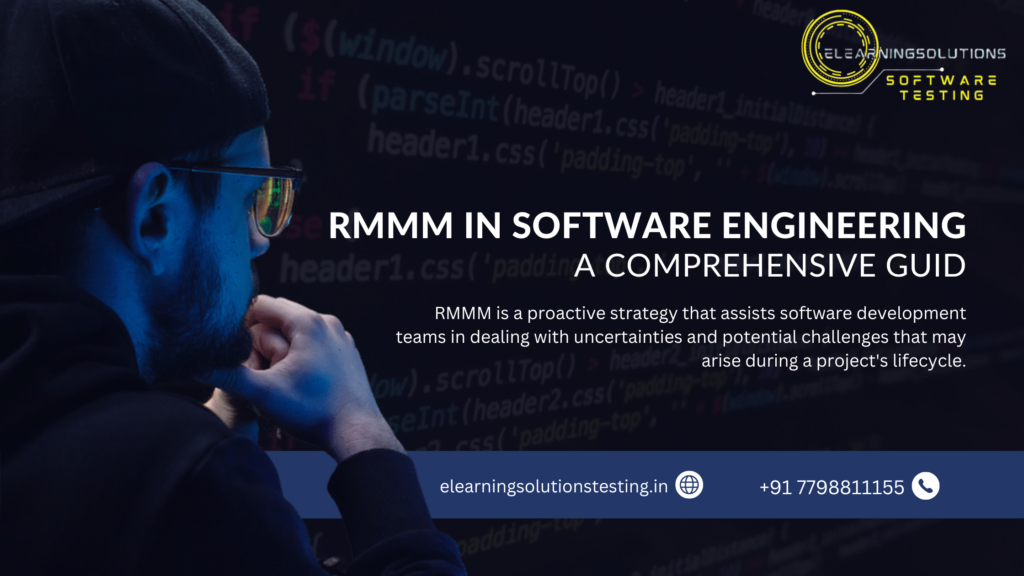Introduction to RMMM
In the realm of software engineering, managing risks is vital for successful project execution. RMMM, which stands for Risk Mitigation, Monitoring, and Management, is a systematic approach that helps identify, assess, and address potential risks throughout the software development lifecycle. In this article, we will delve into the concept of RMMM, its importance in software engineering, and how it ensures the delivery of high-quality software products.
Understanding RMMM
RMMM is a proactive strategy that assists software development teams in dealing with uncertainties and potential challenges that may arise during a project’s lifecycle. It involves the following key components:
1. Risk Identification
The first step of RMMM is to identify potential risks that may impact the project’s success. These risks can be technical, operational, or organizational in nature. Identifying risks early allows teams to develop effective mitigation plans.
2. Risk Assessment
Once risks are identified, they are assessed based on their probability of occurrence and potential impact on the project. This assessment helps prioritize risks and focus on those with the highest severity.
3. Risk Mitigation
Risk mitigation involves taking proactive measures to reduce the likelihood of risk occurrence or minimize its impact. This may include adopting alternative technologies, conducting thorough testing, or refining project plans.
4. Risk Monitoring
Throughout the software development process, risks are continuously monitored to ensure that mitigation strategies remain effective. Regular monitoring helps detect any changes in risk factors and allows for timely adjustments.
5. Risk Management
Risk management encompasses the overall coordination of risk-related activities. It involves making informed decisions, allocating resources, and ensuring that the project stays on track despite potential challenges.
The Importance of RMMM in Software Engineering
RMMM is crucial for the successful execution of software projects due to the following reasons:
1. Ensuring Project Success
By proactively addressing potential risks, RMMMs enhances the project’s chances of success. It allows teams to identify and resolve issues before they escalate into major problems.
2. Improving Resource Utilization
Effective risk management ensures that resources are utilized efficiently. By anticipating and mitigating risks, unnecessary delays and rework are minimized, saving time and effort.
3. Enhancing Stakeholder Confidence
Stakeholders, including clients and investors, gain confidence in the project when they see a well-defined risk management plan. RMMMs demonstrates a proactive approach to addressing challenges.
4. Delivering High-Quality Software
RMMM focuses on quality assurance and reduces the likelihood of defects in the final product. This leads to the delivery of high-quality software that meets or exceeds customer expectations.
Best Practices for Implementing RMMM
To implement RMMMs effectively, software engineering teams should follow these best practices:
1. Involve Stakeholders
Include stakeholders from the early stages of the project to identify and understand their concerns. Their insights can contribute to more comprehensive risk identification.
2. Establish a Risk Register
Maintain a risk register that documents all identified risks, their potential impact, and mitigation plans. This centralized record ensures that risks are well-documented and easily accessible.
3. Plan for Contingencies
Develop contingency plans to address risks that cannot be completely eliminated. Having backup plans in place allows for swift action if a risk materializes.
4. Regularly Review and Update
Continuously review the risk management plan and update it as the project progresses. Regular reviews ensure that the plan remains relevant and effective throughout the software development lifecycle.
Conclusion of RMMM
RMMM is an integral part of software engineering that helps teams tackle uncertainties and potential challenges head-on. By identifying, assessing, and managing risks, software projects can proceed with greater confidence and deliver high-quality results. Effective RMMMs ensures successful project execution, resource optimization, and stakeholder satisfaction.
FAQs
- What does RMMM stand for in software engineering?RMMM stands for Risk Mitigation, Monitoring, and Management. It is a systematic approach to identify and address potential risks during software development.
- Why is RMMM important in software engineering?RMMM is essential for project success as it proactively addresses potential risks, improves resource utilization, and enhances the quality of software products.
- What are the key components of RMMM?The key components of RMMM are risk identification, risk assessment, risk mitigation, risk monitoring, and risk management.
- How does RMMM improve stakeholder confidence?RMMMs demonstrates a proactive approach to addressing challenges, leading to increased stakeholder confidence in the project’s success.
- What are the best practices for implementing RMMM?Best practices for RMMMs include involving stakeholders, maintaining a risk register, planning for contingencies, and regularly reviewing and updating the risk management plan.
Bonuses:
Security Testing: The Ultimate Guide to Types, Techniques, and Tools
Importance of Testing: Critical Role in Software Development
Mastering The Duolingo English Test – Sample Questions And Answers 2024

